One of the weekend garden projects was to put down some mulch around a couple of the fruit trees. I’d resisted doing it earlier because I’d been using the bare ground at the edge of the little orchard as a place to sow various annual wildflower seeds–clarkia, baby blue eyes, poppies, fun things like that. Mulch would have prevented the seed from germinating.
A little garden of annual wildflowers sounds really cool, but it’s a lot of work to keep going. Bare ground during the wet winter and spring weather is an open invitation for all the dormant weed seeds to set up house, and keeping the bed weeded was a several-day-a-week chore.
Add to that that we’re re trying to do more to conserve water. Mulching around the trees to conserve water was making too much sense to not do. Come winter I’ll be glad for the reduced weeding.
The raised bed with the fruit trees still contains some ornamentals near the edges, and I mulched up to near the edges of most of them. This is the local Dudleya edulis, combined with blue chalk fingers, Senecio mandraliscae, from South Africa.
Some of the other plants in the bed were so low-growing that mulching would have covered them entirely. I left a couple little patches of the native Dichondra occidentalis with mulch only at the edges. Hopefully the plant will be able to grow up through the mulch a bit.
This little San Miguel Island buckwheat seedling was large enough to not bury, but a couple seedlings nearby were specks in the dirt that would have never seen the light of day.
For these tiniest seedlings, I left the ground bare. In addition I erected a couple little goalposts to mark the location so I wouldn’t stomped on when I walk through or pull them out thinking they’re a weed. It’s a technique I use whenever I plant some seeds in the open ground. The little upright twigs usually stay around long enough for the seeds to germinate and get to a safe size.
I’ll miss the little meadow in the spring months, but not the weeding. And I feel better that the fig and plum will be able to get by with a little less water. Come fall, if I decide I’d still like some annuals to liven up a garden spot with the bare branches of the trees overhead, there really wouldn’t be anything stopping me from clearing little patches of dirt through the mulch, sowing some wildflowers, and erecting little goalposts to protect the plants from marauding gardeners.
Hmm. I’m not sure why it took me so long to do this…

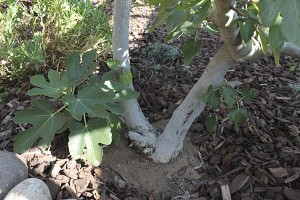
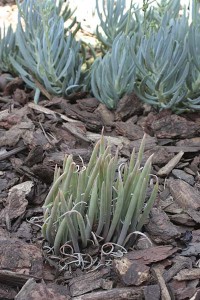
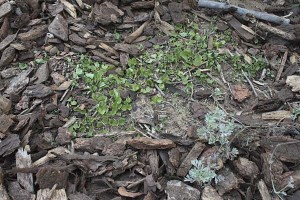
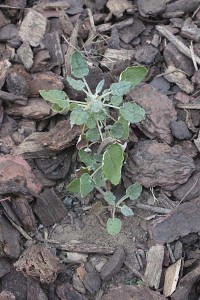
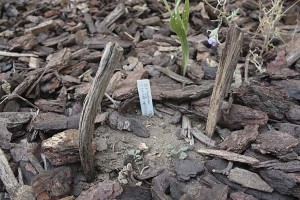
Mulch is so good. Now I finally know what that weed is that keeps sprouting in my garden-buckwheat!
I’ve actually mulched everything, partly for the tidy look, and must say that I’ve still seen a lot of weeds last spring. A real weed won’t mind 4-5 inches of mulch. I pulled and pulled. Maybe it would have been worse without mulch. Now, though, the weeds have dried out and are quiet.
I’ll be curious how it works out for you. Clarkia and Cal Poppies are weedy enough to grow through mulch, but I’m growing other annuals in pots.
Tina, you should be so lucky as to have some cool buckwheat weeds!
Town Mouse, I applied thick mulch to two large areas a year ago, and I’ll say that the difference was huge from the areas with mulch versus those without. It wasn’t an end to weeding by any means, but the chores went way down. I’m glad to hear that clarkias and poppies will make their way through mulch layers. I guess I shouldn’t be surprised with poppies since they’re perennials coming up from root, but it’ll be nice to see the annual clarkias return.
I mulch every spring and fall. Keeps weeds under control, helps keep the soil temperature more even and saves on watering. Plus, I like the looks of a mulched bed. Seems to tie to nature so well.
Mulching is a great way to save water while gardening. It helps to save gallons of water by reducing water evaporation from the soil. It helps trap soil moisture thus reducing the need to water the plants on a daily basis. For more tips on water-wise gardening, refer http://j.mp/n8Okj